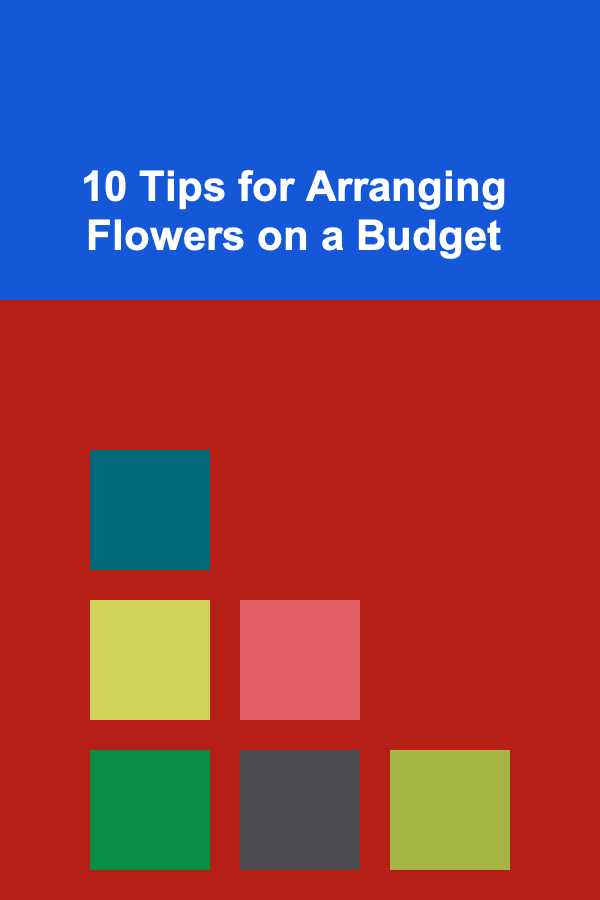
10 Tips for Arranging Flowers on a Budget
ebook include PDF & Audio bundle (Micro Guide)
$12.99$6.99
Limited Time Offer! Order within the next:

Flower arrangements are an essential part of many occasions---whether it's a wedding, a birthday, or just a simple way to brighten your home. However, purchasing expensive arrangements can quickly add up. Fortunately, you don't have to break the bank to create beautiful floral displays. With a little creativity, planning, and some budget-friendly tips, you can craft stunning arrangements without compromising quality or aesthetic.
In this article, we will explore 10 practical tips for arranging flowers on a budget, allowing you to enjoy the beauty of flowers while keeping your costs low.
Buy Seasonal Flowers
One of the easiest ways to reduce the cost of your floral arrangements is to choose seasonal flowers. Seasonal flowers are abundant and often cost less than imported or out-of-season blooms. For example, flowers like daisies, tulips, and sunflowers are typically in-season during spring and summer, while chrysanthemums and carnations can be found in fall and winter.
How to Use Seasonal Flowers:
- Research what flowers are in season in your region at the time of your arrangement.
- Check local farmers' markets or grocery stores for seasonal blooms---they're often fresher and less expensive than those found in flower shops.
Why It Works:
Seasonal flowers are cheaper because they are locally grown and don't require the cost of transportation or climate-controlled environments. Plus, they tend to last longer due to their freshness.
DIY Floral Arrangements
One of the most cost-effective ways to create stunning flower arrangements is to DIY (Do-It-Yourself). Buying loose flowers and arranging them yourself can save you a significant amount of money compared to purchasing pre-made bouquets.
How to Create a DIY Flower Arrangement:
- Start with a few key flowers that you love, then fill in with greenery and fillers like baby's breath, eucalyptus, or ferns.
- Use a simple container like a mason jar, a vintage teacup, or a repurposed bottle to hold your arrangement.
- Watch tutorials on flower arrangement techniques to improve your skills and create designs that look professional.
Why It Works:
By skipping the florist's markup and buying flowers in bulk, you can create beautiful arrangements at a fraction of the cost. Plus, you get to personalize the design to suit your style and occasion.
Repurpose Existing Blooms
If you already have flowers in your home, don't throw them away once they've wilted a little! Instead, repurpose existing blooms and incorporate them into new arrangements.
How to Repurpose Flowers:
- Take wilted flowers and cut them down to their stems, removing any dead petals.
- Combine the remaining fresh flowers with new blooms for a creative and cost-effective arrangement.
- Use smaller vases or containers to display individual stems of flowers that still look fresh.
Why It Works:
Repurposing old flowers reduces waste and ensures you're getting the most out of your floral investment. Plus, it gives you a chance to experiment with new design styles, such as minimalist or single-flower arrangements.
Buy Flowers in Bulk
Buying flowers in bulk is an effective strategy for those on a budget. Wholesale flower vendors and local markets often sell flowers in bulk at discounted prices, allowing you to get more for less.
How to Buy Flowers in Bulk:
- Research local wholesalers who sell flowers at discounted rates for bulk purchases.
- Choose flowers that are easy to arrange and last longer, such as roses, lilies, or orchids.
- Avoid buying flowers that are overly delicate or expensive when purchasing in bulk.
Why It Works:
Buying in bulk saves you money by reducing per-stem costs. This allows you to get a variety of flowers to mix and match in your arrangements, creating diversity without increasing your budget.
Incorporate Foliage and Greenery
If you're trying to keep your flower arrangement costs low, don't underestimate the power of foliage and greenery. Greenery adds volume, texture, and a natural element to your arrangement without the expense of more flowers.
How to Use Foliage:
- Use evergreens, ferns, ivy, or eucalyptus for an elegant touch.
- Fill out the base of your arrangement with green stems and leaves to give it a fuller, more lush look.
- Combine different types of greenery for added texture and variety.
Why It Works:
Greenery is inexpensive and readily available. It can be used to bulk out an arrangement without adding much to your budget, and it enhances the overall aesthetic by complementing the flowers.
Choose Simple, Minimalist Arrangements
Sometimes, less is more. Opting for a simple, minimalist arrangement can be just as impactful as a large, complex one. Fewer flowers can create a modern, sleek look that's both stylish and budget-friendly.
How to Create Minimalist Arrangements:
- Use a single type of flower for a clean, cohesive look---like a cluster of white lilies or bright sunflowers.
- Limit your color palette to a few shades for a sophisticated and elegant arrangement.
- Focus on symmetry and balance in the design.
Why It Works:
Minimalist arrangements use fewer flowers but still achieve a beautiful, refined look. By focusing on quality over quantity, you can create stunning designs without over-spending.
Buy Flowers That Last Longer
When choosing flowers for your arrangement, it's important to consider how long they will last. Long-lasting flowers can stretch your budget because they won't need to be replaced as often.
Best Long-Lasting Flowers:
- Carnations: Known for their durability and wide range of colors.
- Chrysanthemums: These flowers have a long vase life and can stay fresh for weeks.
- Sunflowers: While they may not last as long as some other flowers, they are budget-friendly and can brighten any arrangement.
- Lilies: Known for their elegance and longevity.
Why It Works:
By choosing long-lasting flowers, you ensure that your arrangements will continue to look fresh for longer, maximizing the value of your purchase.
Utilize Flower Filler
Flower filler refers to small flowers or elements that add texture and volume to your arrangement. These fillers are typically inexpensive and can make a big difference in the overall look of your design.
Popular Flower Fillers:
- Baby's breath: Small, delicate flowers that fill space and add a soft, romantic feel.
- Statice: A budget-friendly filler that adds color and texture.
- Solidago: Known for its bright yellow clusters, this is a great addition to any arrangement.
How to Use Fillers:
- Use fillers to complete your arrangement and fill in any empty spaces.
- Experiment with different fillers to create unique textures and color combinations.
Why It Works:
Fillers help bulk up your flower arrangement, giving it a fuller appearance without adding expensive blooms. They're an inexpensive way to elevate your floral designs and make them look more professional.
Look for Discounted Flowers
Many stores, especially grocery stores or florists, offer discounted flowers that are nearing the end of their prime. These flowers may have a shorter shelf life but can still be used for short-term arrangements or events.
How to Find Discounted Flowers:
- Visit your local grocery store, farmer's market, or florists' shop in the evening when they often discount flowers to clear inventory.
- Look for flowers that are just starting to wilt but still have a good amount of bloom left.
Why It Works:
By buying discounted flowers, you can still create beautiful arrangements while paying a fraction of the price. Just make sure you use them quickly to get the most out of your purchase.
Use Creative Containers
You don't need to invest in expensive vases to display your flower arrangements. Instead, use creative containers that you already own or find inexpensive alternatives.
Creative Container Ideas:
- Mason jars: These can be painted or left rustic for a farmhouse-chic look.
- Tea cups: Perfect for small, delicate arrangements.
- Wine bottles: Reuse empty wine bottles as elegant vases.
- Wooden crates: Fill with flowers and place on your dining table for a rustic touch.
Why It Works:
Repurposing containers saves you money and adds a personal touch to your arrangement. Creative containers can complement your flowers and enhance the overall design without the added cost of buying expensive vases.
Conclusion
Flower arrangements don't have to be expensive to be beautiful. By implementing these 10 tips for arranging flowers on a budget, you can create stunning designs that fit your financial needs. Whether you're buying seasonal blooms, using creative containers, or repurposing old flowers, there are countless ways to bring the beauty of nature into your home without overspending.
With a little creativity and planning, you can enjoy the fresh, vibrant look of flowers in your space, all while staying within your budget.
Reading More From Our Other Websites
- [Home Pet Care 101] How to Safely Remove a Tick from Your Pet
- [Personal Investment 101] How to Maximize Your Roth IRA: A Comprehensive Guide for Long-Term Growth
- [Soap Making Tip 101] Best Low‑pH Soap Recipes for Acne‑Prone Skin
- [Home Soundproofing 101] How to Soundproof Your Bathroom for More Privacy
- [Beachcombing Tip 101] From Fossil to Fancy: The Story Behind the Rarest Shell Specimens
- [Home Storage Solution 101] How to Organize Your Craft Room for Maximum Functionality
- [Organization Tip 101] How to Organize Baking Supplies for Quick Access
- [Organization Tip 101] How to Speed Up Your Wallpaper Removal Project with a Steamer
- [Soap Making Tip 101] Scent-sational Creations: Beginner‑Friendly Soap Recipes to Try Today
- [Home Rental Property 101] How to Create a Lease Agreement That Protects Both Parties

How to Access Quality Free Educational Resources for Self-Improvement
Read More
How to Train Your Family to Respond to Home Security Threats
Read More
How To Wear Retro-Inspired Fashion Trends
Read More
How To Learn About DevOps Principles for Coders
Read More
How to Deal with Insecurity in Relationships
Read More
Building a Solar Food Dehydrator: A Comprehensive Guide
Read MoreOther Products

How to Access Quality Free Educational Resources for Self-Improvement
Read More
How to Train Your Family to Respond to Home Security Threats
Read More
How To Wear Retro-Inspired Fashion Trends
Read More
How To Learn About DevOps Principles for Coders
Read More
How to Deal with Insecurity in Relationships
Read More